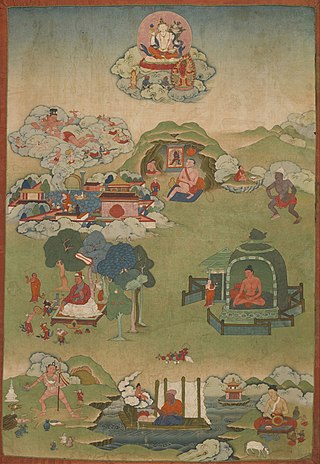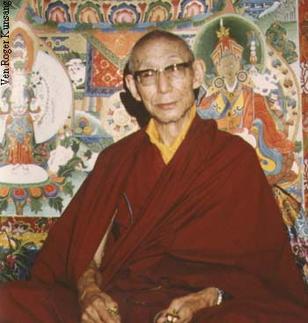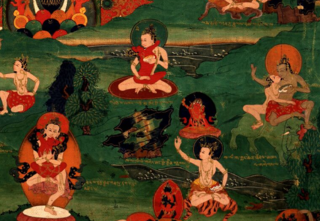
The tree of physiology is a Tibetan thangka depicting human physiology and certain pathological transformations.

The tree of physiology is a Tibetan thangka depicting human physiology and certain pathological transformations.
Tibetan medicine had developed a rather sophisticated knowledge of anatomy and physiology, which was acquired from their long-standing experience with human dissection. Tibetans out of necessity, had long ago adopted the practice of celestial burial (also Sky burial) because of Tibet's harsh terrain in most of the year and deficit of wood for cremation. This form of Sky burial, still practiced, begins with a ritual dissection of the deceased, and then followed by the feeding of the parts to vultures on the hill tops. Both the location of the ritual dissection and the place of feeding is understood as the charnel ground. Over time, anatomical knowledge found its way into Ayurveda [1] and to a lesser extent into China. As result, Tibet has become a home of the Buddhist medical centers Chogppori and Menchikhang (or Menhang), [2] [3] between the twelfth to sixteenth century A.D., where monks came to study even from foreign countries.
Emily Fisher, a trustee at The American Museum of Natural History, donated modern copies of a series of seventy-nine Tibetan Buddhist tangkas (religious paintings) that were originally commissioned in 1687 by the fifth Dalai Lama's regent, Sangye Gyamtso (1653-1705). [4] He had the paintings done to elucidate his commentary on the "Four Tantras" (Tib. Gyushi) [5] - eighth-century Tantric Buddhist texts that form the foundation of Tibetan medicine and cover physiology, pathology, diagnosis, and cure. With such depictions, the Tantric Buddhist system of healing [6] could, according to Sangye Gyamtso, be "perceived by everybody, from the scholar to the child, as dearly as one would see a myrobalan [7] [8] (the foremost healing plant in the Tibetan tradition) held in the palm of one's hand."
The original set of these thangkas, which were kept in Lhasa, were destroyed by the Chinese military in 1959, but these recent copies, based on three surviving sets, were painted over the course of seven years by Nepalese atelier Romio Shrestha, [9] who followed religious and artistic conventions in copying the seventeenth-century originals. Shrestha's paintings on cloth, which are filled with astonishing renditions of a variety of physical conditions and illnesses, have been digitally photographed and incorporated into the Museum of Natural History, Division of Anthropology's image database.

Tibetan Buddhism is a form of Buddhism practiced in Tibet, Bhutan and Mongolia. It also has a sizable number of adherents in the areas surrounding the Himalayas, including the Indian regions of Ladakh, Sikkim, and Arunachal Pradesh, as well as in Nepal. Smaller groups of practitioners can be found in Central Asia, Xinjiang, Inner Mongolia, and some regions of Russia, such as Tuva, Buryatia, and Kalmykia.

Vajrayāna, also known as Mantrayāna, Mantranāya, Guhyamantrayāna, Tantrayāna, Tantric Buddhism, and Esoteric Buddhism, is a Buddhist tradition of tantric practice that developed in the Indian subcontinent and spread to Tibet, Nepal, other Himalayan states, East Asia, and Mongolia.

The Gelug is the newest of the four major schools of Tibetan Buddhism. It was founded by Je Tsongkhapa (1357–1419), a Tibetan philosopher, tantric yogi and lama and further expanded and developed by his disciples.

Yamāntaka or Vajrabhairava is the "destroyer of death" deity of Vajrayana Buddhism. Sometimes he is conceptualized as "conqueror of the lord of death". Of the several deities in the Buddhist pantheon named 'Yamāntaka', the most well known, also called as 'Vajrabhairava' belongs to the Anuttarayoga Tantra class of deities popular within the Gelug school of Tibetan Buddhism.
Mindstream (citta-santāna) in Buddhist philosophy is the moment-to-moment continuum of sense impressions and mental phenomena, which is also described as continuing from one life to another.

Traditional Tibetan medicine, also known as Sowa-Rigpa medicine, is a centuries-old traditional medical system that employs a complex approach to diagnosis, incorporating techniques such as pulse analysis and urinalysis, and utilizes behavior and dietary modification, medicines composed of natural materials and physical therapies to treat illness.

Tibetan tantric practice, also known as "the practice of secret mantra", and "tantric techniques", refers to the main tantric practices in Tibetan Buddhism. The great Rime scholar Jamgön Kongtrül refers to this as "the Process of Meditation in the Indestructible Way of Secret Mantra" and also as "the way of mantra," "way of method" and "the secret way" in his Treasury of Knowledge. These Vajrayāna Buddhist practices are mainly drawn from the Buddhist tantras and are generally not found in "common" Mahayana. These practices are seen by Tibetan Buddhists as the fastest and most powerful path to Buddhahood.

Glenn H. Mullin is a Tibetologist, Buddhist writer, translator of classical Tibetan literature and teacher of Tantric Buddhist meditation.

Lha-bzang Khan was the ruler of the Khoshut tribe of the Oirats. He was the son of Tenzin Dalai Khan (1668–1701) and grandson of Güshi Khan, being the last khan of the Khoshut Khanate and Oirat King of Tibet. He acquired effective power as ruler of Tibet by eliminating the regent (desi) Sangye Gyatso and the Sixth Dalai Lama, Tsangyang Gyatso, but his rule was cut short by an invasion by another group of Oirats, the Dzungar people. At length, this led to the direct involvement of the Chinese Qing dynasty in the Tibetan politics.

Desi Sangye Gyatso (1653–1705) was the sixth regent (desi) of the 5th Dalai Lama (1617–1682) in the Ganden Phodrang government. He founded the School of Medicine and Astrology called Men-Tsee-Khang on Chagpori in 1694 and wrote the Blue Beryl treatise. His name is sometimes written as Sangye Gyamtso and Sans-rGyas rGya-mTsho
Thekchen Choling is a registered Buddhist organisation in the Republic of Singapore. The organisation was started in 2001 by Singha Thekchen Rinpoche and a group of his initial disciples. The organisation promotes non-sectarian Buddhism, emphasizing understanding of Theravada and Mahayana teachings. TCCL is committed to the Rime (non-sectarian) movement within Tibetan Buddhism though it is of the Gelug tradition. The primary practices and teachings of this temple are from Guru Rinpoche lineage and Lama Tsongkapa lineage.
Lung means wind or breath. It is a key concept in the Vajrayana traditions of Tibetan Buddhism and has a variety of meanings. Lung is a concept that is particularly important to understandings of the subtle body and the trikaya. Traditional Tibetan medicine practitioner Tamdin Sither Bradley provides a summary:
The general description of rLung is that it is a subtle flow of energy and out of the five elements it is most closely connected with air. However it is not simply the air which we breathe or the wind in our stomachs, it goes much deeper than that. rLung is like a horse and the mind is the rider, if there is something wrong with the horse the rider will not be able to ride properly. Its description is that it is rough, light, cool, thin, hard, movable. The general function of rLung is to help growth, movement of the body, exhalation and inhalation and to aid the function of mind, speech and body. rLung helps to separate in our stomachs what we eat into nutrients and waste products. However its most important function is to carry the movements of mind, speech and body. The nature of rLung is both hot and cold.

Dampa Sangye was a Buddhist mahasiddha of the Indian Tantra movement who transmitted many teachings based on both Sutrayana and Tantrayana to Buddhist practitioners in Tibet in the late 11th century. He travelled to Tibet more than five times. On his third trip from India to Tibet he met Machig Labdrön. Dampa Sangye appears in many of the lineages of Chöd and so in Tibet he is known as the Father of Chod, however perhaps his best known teaching is "the Pacification". This teaching became an element of the Mahamudra Chöd lineages founded by Machig Labdrön.

Buddhism in the Himachal Pradesh state of India of has been a long-recorded practice. The spread of Buddhism in the region has occurred intermediately throughout its history. Starting in the 3rd century BCE, Buddhism was propagated by the Maurya Empire under the reign of Ashoka. The region would remain an important center for Buddhism under the Kushan Empire and its vassals. Over the centuries the following of Buddhism has greatly fluctuated. Yet by experiencing revivals and migrations, Buddhism continued to be rooted in the region, particularly in the Lahaul, Spiti and Kinnaur valleys.

The Third Trijang Rinpoche, Lobsang Yeshe Tenzin Gyatso (1901–1981) was a Gelugpa Lama and a direct disciple of Pabongkhapa Déchen Nyingpo. He succeeded Ling Rinpoche as the junior tutor of the 14th Dalai Lama when the Dalai Lama was nineteen years old. He was also a lama of many Gelug lamas who taught in the West including Zong Rinpoche, Geshe Rabten, Lama Yeshe, Kelsang Gyatso, and Lama Zopa Rinpoche. Trijang Rinpoche's oral teachings were recorded by Zimey Rinpoche in a book called the Yellow Book.

Karmamudrā is a Vajrayana Buddhist technique which makes use of sexual union with a physical or visualized consort as well as the practice of inner heat (tummo) to achieve a non-dual state of bliss and insight into emptiness. In Tibetan Buddhism, proficiency in inner heat yoga is generally seen as a prerequisite to the practice of karmamudrā.

Yuthok Yonten Gonpo the Younger (1126–1202) was a Tibetan doctor and ngakpa, credited with composing the Four Medical Tantras, a four-book treatise on Traditional Tibetan Medicine which forms the main course of study in the Tibetan medical tradition. He is widely regarded as the main founder of Tibetan medicine, mostly based on his composition of the Four Medical Tantras. His other important contribution to Tibetan culture was the Yuthok Nyingthik, whose full name is the Yuthok Nyingthik Guru Sādhanā, ‘Compassionate Sunlight for Dispersing Suffering’s Darkness’, which is the main Tantric Buddhist practice-cycle associated with Tibetan medicine. It is traditionally considered to be an important spiritual component of healing in Tibetan medical culture, and moreover is regarded in all Tibetan Buddhist traditions as a very special method for attaining awakening and realization quickly.

Tibet Center Institute – International Institute of Higher Tibetan Studies was founded by the 14th Dalai Lama, Lama Geshe Tenzin Dhargye and the Tibet Office Geneva with the support of the Carinthian state government and is located in Knappenberg in the region of Hüttenberg, Carinthia, Austria. The institute provides an authentic and secular education program on Tibet's authentic knowledge and culture on an academic level which makes it unique in Europe.

Yeshi Dhonden was a Tibetan doctor of traditional Tibetan medicine, and served the 14th Dalai Lama from 1961 to 1980. In 2018, the Indian government honoured him with the Padma Shri, the fourth highest civilian award in India.
Classes of Tantra in Tibetan Buddhism refers to the categorization of Buddhist tantric scriptures in Indo-Tibetan Buddhism. Tibetan Buddhism inherited numerous tantras and forms of tantric practice from medieval Indian Buddhist Tantra. There were various ways of categorizing these tantras in India. In Tibet, the Sarma schools categorize tantric scriptures into four classes, while the Nyingma (Ancients) school use six classes of tantra.